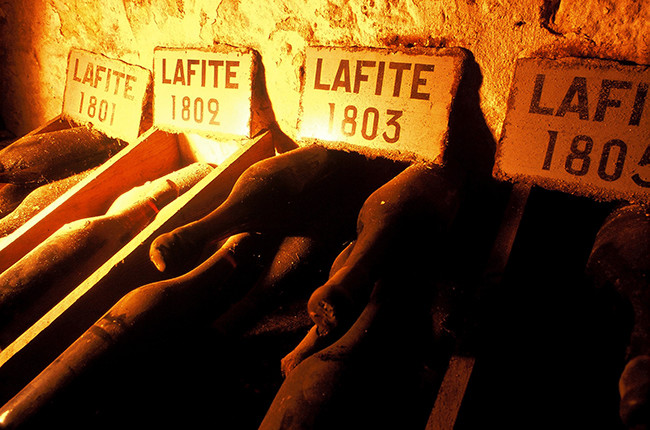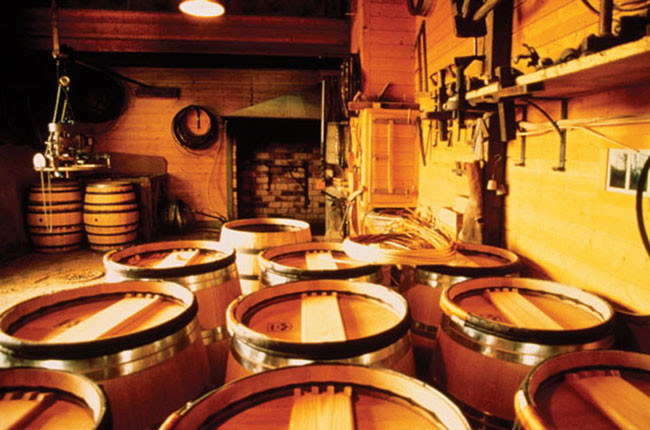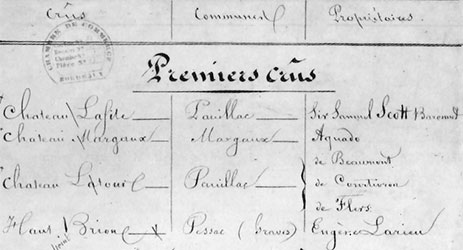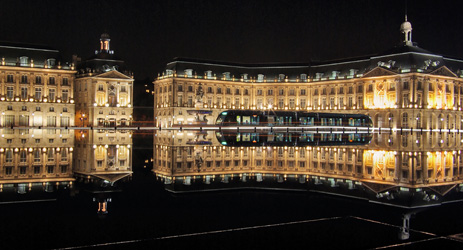An increasing number of terroir-driven French estates are leaving the appellations body that is meant to protect their provenance and guarantee consumers a unique product. Isabelle Legeron MW believes the system is flawed and outdated, and no longer an indicator of wine quality
*Originally published in Feb 2013 issue of Decanter magazine

Decanter’s Andre w Jefford once described ‘the fundamental greatness’ of the French Appellation d’Origine Contrôlée (AOC or AC) system as being due to the fact they are collective property rights, permitting individual, often small, growers to thrive in a ‘world dominated by the homogenising fetish of “the brand”.’
‘It is a glorious concept,’ agrees Nicolas Joly, Loire producer and founder of grower association Renaissance des Appellations. ‘It came about when people living in a particular place noticed that plants, or animals, raised in that location expressed flavours that were not possible elsewhere. It was a powerful guarantee for consumers: if wine carried the name of a place, you knew you were guaranteed the flavours of that place in that bottle.’
However, over the past few decades, more and more of France’s terroir-driven growers have either been ejected from or chosen to leave the system. The question is why? Do the reasons reflect badly on the AC, its governing bodies or the wines that are accredited by the system? And what does it mean for wine drinkers? Can we still put our faith in this ‘glorious concept’, or is it time to rethink its practical value?
Protecting identity
The first French attempts to formalise a system that would safeguard appellations, for both producers and consumers, began in 1905. Initially aimed at protecting geographical provenance following rampant wine adulteration and fraud, it evolved to include a comprehensive raft of procedures and enforcement mechanisms, culminating in the creation of the Appellation d’Origine Contrôlée (or AC) and its regulatory body the INAO, the Institut National de l’Origine et de la Qualité.
The model proved so successful it was later extended to include other products like cheese and lavender, alongside the 357 wine ACs in place today. The fundamental aim, though, remains the same: to be ‘a collective enterprise, created by human beings to protect a product which they have created and that is different to similar products made by their neighbours’, says Christian Paly, president of the INAO’s national committee of ACs, for wine, alcoholic drinks and eaux-de-vie.
In order to be granted AC status, a grower’s vineyard has to be located within a specific area, they have to grow grapes and make wine in accordance with the ‘cahier des charges’ (or rule book) and they have to pass an accreditation tasting. Each cahier des charges is drawn up by local syndicates of producers, which also select and train tasting panels. Independent, accredited organisations (such as ICONE or Quali-Bordeaux) ensure compliance with the cahier des charges and organise the accreditation tastings.
This system is constantly evolving: the cahiers des charges can be revised and new ACs appear regularly. ‘ACs are living languages: ACs from 70 years ago are no longer the ACs of today, and in another 70 years, they will be different again,’ explains Paly.
Unfortunately, this very ability to evolve often challenges France’s most traditional of producers. ‘In Burgundy we have parcels that have been identified as unique for centuries, if not millennia… is it really reasonable to think that someone with 20 years of experience can turn that on its head? Absolutely not,’ says Yannick Champ, joint manager of Domaine Prieuré-Roch, one of Burgundy’s most well-known producers.
Falling short of AC requirements can happen at one of two stages: either in relation to the cahier des charges, or at the tasting. Changes in varietal planting criteria, for example, saw Domaine de Trévallon famously ejected from the very AC Baux de Provence it helped create in the 1990s, while recent changes in the Rhône Valley regulations now mean that Jérôme Bressy, owner of Gourt de Mautens, can no longer use his indigenous grape varieties to make Côtes du Rhône and Rasteau. ‘They have decided to exclude old, heritage varieties like Picardan and Picpoul Gris, which were planted because of their suitability for hot climates and bringing freshness to blends,’ says Bressy. ‘Laws like these erase our history and culture. It’s devastating.’
Bressy insists this has changed radically since the AC’s beginnings: ‘ACs used to ensure the loyal and constant usage of the earth. There was a real vigneron culture based around observation and protection of heritage. Today it’s all about pressure from commercial labs.’ James Gauthier, technical advisor at the INAO in the Loire from 1955 to 1992, says that in his opinion the mistake has been to separate the INAO from realities on the ground: ‘Before, INAO was full of agronomists. Now they’re straight out of the Grandes Ecoles [business schools]. They’re technocrats not agriculturalists.’

Breaking the rules
This weighty bureaucracy can sometimes mean the radical enforcement of petty rules. Small, artisan Loire producer Olivier Cousin, who has been fighting the system since 1992, recently found himself facing France’s national fraud squad in court for breaching AC labelling rules by indicating the geographical provenance of his wine – Anjou.
‘INAO has reserved the right to all French words that are seen to add value to a wine: ‘terroir’, ‘domaine’, ‘clos’, ‘château’ or ‘grand vin’. It is outrageous,’ exclaims Cousin, who faces the prospect of a fine totalling tens of thousands of euros, and possibly jail*.
(*Follow-up report: Rebel Loire Valley winemaker fined two euros)
Patrick Bouju, of Domaine La Bohème, found himself in a similar situation. ‘I really didn’t want to leave the appellation because I was proud of Auvergne, my region. But since it is not worthwhile fighting the administration, I left.’ The result? ‘They still audit me to make sure I don’t breach AC rules – they even checked my website and gave me a caution for indicating where in France my vineyard was located. As a Vin de Table I cannot give any geographical information, not even my address。”
The most contentious issue, though, is the accreditation tasting. Introduced in 1974, it has been a problematic element ever since. ‘The tasting is definitely the main problem of the AC today,’ says Champ. ‘It doesn’t stop bad wines getting through, but it regularly rejects excellent wines.’ As Joly explains: ‘They don’t say that your wine is not good, but that it is too different from the AC’s “defined taste” for you to be included.’
Quali-Bordeaux officials agree: ‘Some wines fall outside the framework of the AC, and those, yes, are likely to be rejected. They may be wines that have a market, clients, and even have distinct personalities, but they are likely to be rejected by the tasting panels because their tasting profiles are outside those set by the appellation. It isn’t a reflection on their quality.’
The problem goes even deeper as appellations seem to be eroding the very essence of what it is to be an appellation. Following a tricky vintage and tiny yields in 2008, Prieuré-Roch saw its Nuits-St- Georges initially refused appellation because the wines had not been chaptalised (had sugar added) and were consequently significantly lower in alcohol than others. Similarly, Alain Dejean from Rousset Peyraguey was excluded from AC Sauternes for not having the required flavour profile. ‘They say our wines should showcase exotic fruit flavours, pineapple and grapefruit, which is impossible through noble rot. Botrytis wines always exhibit candied fruits such as apricot, dates and figs. To get exotic fruits means you have to add yeasts, and since there are two main types of yeast used for sweet wines, it is unsurprising they all taste the same,’ explains Dejean, whose wine, fermented without adding yeasts, is ironically the Maison du Sauternes’ bestseller in the syndicate’s official wine shop. If ACs are indeed to protect fundamental components such as terroir and climate, then surely excluding wines because they are free of added sugar in a weak vintage, or because they have not been made with added yeasts, should sound alarm bells in the ranks of the INAO. As Joly puts it, ‘How much of the appellation is still in the bottle today? Very little. It’s a colossal mistake because we are losing a country’s intrinsic wealth.’
Fighting back

Producers, however, are challenging the status quo. The renowned Château Le Puy in Bordeaux won a landmark legal battle against the INAO in June 2012, overturning its decision to declassify Le Puy’s 2005 vintage. ‘They are trying to format individual wines in order to arrive at one single expression of the appellation. It’s certainly the easy option in terms of marketing, but it is totally contra to the spirit of the AC, especially since those wines that express real terroir don’t get through,’ says winery owner Jean-Pierre Amoreau.
Guy Baudin in Pouilly-Fumé is following suit. Having kept production methods the same for decades, Baudin was shocked to discover that his entire 2010 vintage had been declassified. ‘We broadly work like our ancestors did: manual harvesting, soil cultivation, indigenous yeasts... This is how everyone used to work. But now, with the advent of technological wines and added yeasts, we’re the ones who stick out. It is a major problem,’ says Claire Baudin, his wife. The couple has also started legal proceedings against the INAO.
‘The issue is that in prestigious appellations such as Sancerre and Pouilly-Fumé, producers don’t question their practices: “It works, we make money, why should we change”. Whereas, in appellations with nothing to lose, people are happier to question the status quo. Consequently, tasters too are far more open-minded during accreditation sessions,’ says Alexandre Bain, arguably Pouilly-Fumé’s best producer, whose wines grace the tables of two- and three-star Michelin restaurants, and yet struggles with AC accreditation back home.
Positive developments in Burgundy bode well for those on the edge. ‘ICONE has recognised that there is a problem and has given itself six months to come up with a solution for wines they coin “wines with strong personalities”, which are currently being excluded by the system,’ says Champ.
What guarantee is the AC?
Until tangible changes occur, however, the question is what this means for the ordinary wine drinker. If terroir is under fire, can we at least expect a seal of quality among AC wines? The UK wine trade is unsure. ‘The AC itself is not a guarantee of quality but remains relevant as a powerful indicator of grape variety, style and origin,’ says Anthony Moss MW from the Wine & Spirit Education Trust.
Anthony Rose, Decanter contributor and wine correspondent for The Independent, agrees: ‘I don’t bother with appellations – it lulls consumers into a false sense of security and allows producers to rest on their laurels, particularly when compared to growers in other countries with no such system who have to prove themselves on the basis of quality alone.’
Nowhere is this clearer than in the St-Emilion grand cru classification announced in September 2012. Updated every 10 years, it informs high-spending buyers’ choices the world over. In addition to a tasting score, points are awarded on the price of candidates’ wines, how many hits the property gets on Google or whether or not they have a seminar room to receive guests (see box below).
‘Are we classifying terroir and wine, or attractive cellars with powerful means of communication?’ says Pierre Carle from Croque-Michotte.
‘There are lots of examples of idiocy in the system, especially due to human frailty,’ says Julia Harding MW from JancisRobinson.com. ‘But even with all these caveats, on the whole it’s a good system.’
ACs no longer guarantee terroir nor quality – you are, for example, just as likely to find great wines in the supposedly ‘lesser’ vin de France category. They do guarantee the standardised styles seemingly developed in an attempt to compete in an increasingly tough, globalised world. But this means haemorrhaging heritage and losing good producers in favour of the vagaries of the market, which seems a shame if not short-sighted. Surely individuality and the inimitable uniqueness of terroir are surer bets in the long-term? Perhaps it is time for the INAO to work out how best to welcome back the outliers into the fold. As Chablis producer Athénaïs de Béru asks, ‘If those who produce wines with typicity abandon the appellation, then what future does the appellation really have?’ Isabelle Legeron MW is a wine writer, broadcaster and educator who runs her own events company, Wine Lab
How St-Emilion grand cru classé properties are assessed

In a system unique to the St-Emilion AC, St-Emilion grand cru properties are classified every 10 years.
The classifications of grand cru classé and premier grand cru classé are awarded by the INAO and are valid for 10 years. They command high prices on the global market and are highly sought after by producers and buyers alike.
To qualify for classification, properties are assessed according to various criteria and are given a score out of 20. These various scores are then weighted according to importance, and a final score calculated. Below is the list of criteria, together with their weightings in the final calculation per classification:
St-Emilion grand cru classé AC
Final total must > 14
50% Tasting
20% Famousness: how luxurious and sought-after your château is. This is determined through various ‘tests’ including counting how many times the château is mentioned in wine guides and magazines; its ranking on internet search engines; the release prices of its wines (the more expensive your wine the more points you get); and so on. Extra credit is awarded, for example, to châteaux boasting seminar rooms and those that have produced marketing films about their domaines in four different languages).
20% Topography and geology: this is primarily determined by soil type but is also dependent upon the physical proximity of your vines to your château
10%: Viticulture (for example, vine density) and vinification (temperaturecontrolled vats get extra points)
St-Emilion premier grand cru classé AC
Final total must > 16
If your châteaux wines are thought to be particularly ageworthy and you are thought to be extra famous, then you will be granted an A, rather than B, bonus classification within the premier grand cru classé classification itself.
30% Tasting
35% Famousness
30% Topography and geology
5% Viticulture and vinification
Translated by ICY
All rights reserved by Future plc. No part of this publication may be reproduced, distributed or transmitted in any form or by any means without the prior written permission of Decanter.
Only Official Media Partners (see About us) of DecanterChina.com may republish part of the content from the site without prior permission under strict Terms & Conditions. Contact china@decanter.com to learn about how to become an Official Media Partner of DecanterChina.com.










Comments
Submit